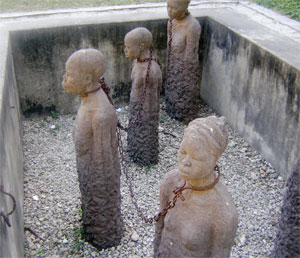By Joe Ombuor
As Zanzibar pops into sight out of the expansive Indian Ocean waters, a visitor bored by the monotony that is the drone and chugging of a marine engine envisions a rich date with history. An initial recipe to the rich menu ahead is the eerie yet magnificent white faÁade of Stone Town, built on the sweat and blood of African slaves long before Nairobi, Mombasa or Dar es Salaam were built.
An architectural showcase of palaces, fortes, residential houses, mosques, churches and graves, history has it that from Stone Town, Omani Arabs controlled 1,000 miles of the East and Central African mainland comprising present day Tanzania, Kenya, Mozambique, Zambia, Rwanda, Burundi, Somalia and Congo. This vast area formed their catchment for slaves who were marketed far and wide from a spot in the town. The mother to Zanzibar’s first President, Sheikh Abeid Amani Karume hailed from then Rwanda Urundi (today Rwanda and Burundi).
 |
There are many reminders of the slave trade at the East African coast. |
Kiswahili scholars arriving in Zanzibar cannot contain the fascination of stepping into the cradle of the language that has fanned out to become Africa’s foremost lingua franca. The word, Swahili derives from the Arab word, sawahil, which means coast. It evolved from widespread intermarriage between Shirazi Persian Arabs from the Middle East, said to have settled in the East African Coast including Zanzibar as early as the 11th and 12 th centuries. A mosque at Kizimkazi on the Southern tip of the main Unguja Island is said to have been built in 1107 AD.
Shortest War
Stone Town was the scene of the shortest war ever fought in history when the British army descended on the sultan’s palace 114 years ago to stop a sultan whom they considered unfriendly to their interests. The war lasted 40 minutes.
According to records at the palace, the war followed the death of pro-British Sultan Hamud bin Thuwain on August 25, 1896 and the usurping of power by his nephew, Seyyid Khalid bin Barghash whom the British considered hostile to their interests. When guns fell silent after 40 minutes, part of the palace was badly damaged and pro British Hamud bin Muhamed was the Sultan after Khalif fled to the German consulate.
For a Kenyan catching a glimpse of Stone Town for the first time, what immediately comes to mind is that a 10 mile coastal strip, including the port city of Mombasa, was once ruled from here by the Sultan. It is also striking that the controversy that are the Kadhis’ courts also had their roots here.
Civilisation Hub
Long before the rest of East Africa had electricity, the Sultan of Zanzibar was enjoying the facility at his palace in Stone Town in the late 1880s. Colour television was first viewed in Stone Town when mainland Tanzania had no television at all and ‘black and white’ images was all that Kenyans and Ugandans knew. The British put up the first telecommunications mast in the region here.
Right from the landing wharf where the vessel docks after a 45 kilometre cruise from Dar es Salaam, Stone Town is a study in antiquated structures, narrow, winding alleys, bustling bazaars, mosques and grand Arab houses with brass-studded, carved, wooden doors that are a throw back to a forgotten era.
A brief walk in the sweltering heat takes you to some of the oldest mosques on the East African coast, 51 of them located within Stone Town alone. The echoing of muezzin calls for prayers is a common feature in the ancient town that has changed little with time. Within eyeshot is the palace that housed the 12 Sultans of Zanzibar up to 1964, eleven of whom are buried in tombs in the palace compound. The oldest of tombs is that of Seyyid Said bin Sultan (Seyyid Said the Great) who moved his capital of the Omani empire from Muscat in his native Oman to Stone Town in 1840. He died in 1856.
Adjoining what is today the palace museum is the house of wonders (Beit El Ajaib) built in 1883 by Sultan Barghash bin Said (the third Sultan of Zanzibar) as a grand palace for ceremonies. It is now a museum and houses some Government departments.
The architecture in Stone Town is mainly Arabic, featuring very thick walls. Many of them are tall with square and simple facades plus a central courtyard running through all the floors for ventilation through the cool breeze from the sea.
Stay informed. Subscribe to our newsletter
One cannot fail to notice the uniqueness of the doors. Residents say the doors with brass studs came from India where they were used to protect buildings from elephants while those with horizontal lintels are the oldest and reflect styles from Oman and Arabia. Most doors feature varying motifs of dates, fish, chains, flowers, lotus and other carvings.
Old Forte
A short distance away from the quay is Saint Joseph’s Catholic Cathedral, a coralline building whose foot facing the sea is washed by high tides. The cathedral, standing at the spot where slaves disembarked en route to the notorious slave market was built between 1893 and 1898 and designed by the same architect who designed the Notre Dame basilica at Marseilles in France.
Though no train runs in Zanzibar now, the second railway line in East Africa ran eight kilometres from Stone Town to the outskirts at Bububu village where it reached in 1905, four years after the Kenya/Uganda railway line reached Kisumu from Mombasa. The old forte built around 1700 by Seyyid Said’s grandfather later became a depot for the Stone Town/Bububu railway. It was used in the days of yore by the Arabs to repel the Portuguese and their allies.
Today, Stone Town hosts the State University of Zanzibar, the Serena Hotel, the Zanzibar High Court and the Zanzibar Municipal Council offices.
Just outside the prehistoric town is the busy Darajani area famous for its open and indoor markets where everything from fish, meat, fruits, bread, coconut, dates and food are sold. Once the night falls, the open market converts into an open air eating place where all foods are available.
Darajani also serves as the terminus for public transport vehicles plying the Island routes, from Kizimkazi in the south to Mkokotoni in the north.
 The Standard Group Plc is a
multi-media organization with investments in media platforms spanning newspaper
print operations, television, radio broadcasting, digital and online services. The
Standard Group is recognized as a leading multi-media house in Kenya with a key
influence in matters of national and international interest.
The Standard Group Plc is a
multi-media organization with investments in media platforms spanning newspaper
print operations, television, radio broadcasting, digital and online services. The
Standard Group is recognized as a leading multi-media house in Kenya with a key
influence in matters of national and international interest.
 The Standard Group Plc is a
multi-media organization with investments in media platforms spanning newspaper
print operations, television, radio broadcasting, digital and online services. The
Standard Group is recognized as a leading multi-media house in Kenya with a key
influence in matters of national and international interest.
The Standard Group Plc is a
multi-media organization with investments in media platforms spanning newspaper
print operations, television, radio broadcasting, digital and online services. The
Standard Group is recognized as a leading multi-media house in Kenya with a key
influence in matters of national and international interest.







